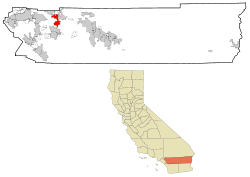Beaumont, California
| City of Beaumont | |
|---|---|
| City | |
 Location in Riverside County and the state of California |
|
| Location in the United States | |
| Coordinates: 33°55′46″N 116°58′38″W / 33.92944°N 116.97722°WCoordinates: 33°55′46″N 116°58′38″W / 33.92944°N 116.97722°W | |
| Country |
|
| State |
|
| County | Riverside |
| Incorporated | November 18, 1912 |
| Area | |
| • Total | 30.926 sq mi (80.098 km2) |
| • Land | 30.912 sq mi (80.062 km2) |
| • Water | 0.014 sq mi (0.036 km2) 0.04% |
| Elevation | 2,612 ft (796 m) |
| Population (April 1, 2010) | |
| • Total | 36,877 |
| • Estimate (2013) | 40,481 |
| • Density | 1,200/sq mi (460/km2) |
| Time zone | PST (UTC-8) |
| • Summer (DST) | PDT (UTC-7) |
| ZIP code | 92223 |
| Area code | 951 |
| FIPS code | 06-04758 |
| GNIS feature IDs | 1660318, 2409805 |
| Website | ci |
Beaumont is a city in Riverside County, California, United States located at a half mile elevation in the pass area south of Southern California's highest peak, San Gorgonio Mountain, and north of San Jacinto Peak.
Beaumont is bordered on the east by the city of Banning, on the south by the city of San Jacinto, on the west by the city of Calimesa, and on the north by the unincorporated community of Cherry Valley.
During the early 1850s, many surveying parties passed through the vicinity of present-day Beaumont in search of a pass that would connect the east to the Pacific Ocean. The San Gorgonio Pass was discovered in 1853 by a surveying expedition under Lieutenant R.S. Williamson, who was sent by the United States government. Its discovery enthralled many who now saw that connecting to the ocean was a feasible measure and led to plans for connecting a railway from the Missouri River to the Pacific. By the early 1860s, the Southern Pacific Railroad had laid tracks through the modern-day location of Beaumont. At the summit of the pass, a site was founded and named Edgar Station after a physician from one of the original expedition parties. Edgar Station served as a rest stop for railway travelers from the Mojave Desert on their way to the Los Angeles vicinity. Soon Edgar Station changed its name to San Gorgonio, named by a real estate development company, and it gradually attracted permanent residents.
The sleepy town of San Gorgonio became an incorporated Californian city on November 18, 1912, and adopted its current name of Beaumont (French for "beautiful mountain"). As of 1927, the town boasted a small population of 857 with five churches, a public library, a bank, a high school, two local newspapers, several lumber yards, commercial packing houses, and a dehydrating plant. The city, one of Riverside County's largest apple growers, was dubbed "the land of the big red apple" by local residents in its early years. Apple orchards in and around the town expanded to a $200,000 industry by 1930. Beaumont saw a rise in visitors and residents as the little-known nearby city of Palm Springs to the east grew to become a highly popular resort spot in the 1930s and after; Beaumont followed suit and attempted to capitalize on the tourism by establishing guest ranches. According to an early 1930s/1940s postcard, the Highland Springs Guest Ranch of Beaumont offered its patrons horseback riding, tennis, archery, horseshoes, swimming, shuffle-board, ping pong, baseball, ballroom dancing, massage, basketball, as well as a place to spend the night.
...
Wikipedia

